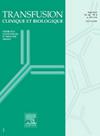四联体诱导治疗对新诊断多发性骨髓瘤干细胞动员产量的影响。
IF 1.2
4区 医学
Q4 HEMATOLOGY
引用次数: 0
摘要
含有daratumumab的四联体诱导方案最近已成为新诊断的多发性骨髓瘤患者的标准治疗方案,这些患者是自体造血干细胞移植的候选人。Daratumumab是一种已知的免疫抑制剂,先前的研究表明它可能损害干细胞动员产量。我们报告了一项对104名新诊断的多发性骨髓瘤患者的回顾性研究,比较了接受含四联体达拉图单抗诱导和接受传统三药诱导的患者的动员率。我们的结果表明,在首次动员尝试后,含达拉图单抗组和不含达拉图单抗组的患者在达到患者特异性最低所需的CD34+细胞产量方面没有统计学上的显著差异(P = 0.28)。然而,与接受传统三药诱导的患者相比,接受达拉图单抗四联体诱导方案的患者采珠时间更长(含达拉图单抗组中位为2天,不含达拉图单抗组中位为1天,P = 0.011),具有统计学意义。我们的研究结果加强了将粒细胞集落刺激因子和多立沙酮结合到动员实践中的重要性。此外,这项研究的发现可能会对采血机的明智使用产生影响,并进一步为新诊断的多发性骨髓瘤提供含有daratumumab的诱导疗法的最佳递送。本文章由计算机程序翻译,如有差异,请以英文原文为准。
Impact of quadruplet induction therapy on stem cell mobilization yields in newly diagnosed multiple myeloma
Daratumumab-containing quadruplet induction regimens have recently become the standard of care for patients with newly diagnosed multiple myeloma who are candidates for autologous hematopoietic stem cell transplantation. Daratumumab is a known immunosuppressant, and previous studies have shown that it may impair stem cell mobilization yields. We report a retrospective study of 104 newly diagnosed multiple myeloma patients comparing mobilization yields between those who received quadruplet daratumumab-containing induction and those who received traditional three-drug induction. Our results demonstrated that there were no statistically significant differences in achieving the patient-specific minimally required CD34+ cell yield after the first mobilization attempt between patients in the daratumumab-containing arm and those in the non-daratumumab-containing arm (P = 0.28).However, patients who received the quadruplet induction regimen with daratumumab experienced a statistically significant longer duration of apheresis collection (median of 2 days in the daratumumab-containing arm vs. 1 day in the non-daratumumab-containing arm, P = 0.011) than those who received traditional three-drug induction.Our findings reinforce the importance of incorporating both granulocyte-colony stimulating factors and plerixafor upfront into mobilization practices. Furthermore, the findings of this study may have implications for the judicious use of apheresis machines and further inform the optimal delivery of daratumumab-containing induction therapies for newly diagnosed multiple myeloma.
求助全文
通过发布文献求助,成功后即可免费获取论文全文。
去求助
来源期刊
CiteScore
2.50
自引率
11.80%
发文量
234
审稿时长
36 days
期刊介绍:
Transfusion Clinique et Biologique, the official journal of the French Society of Blood Transfusion (SFTS):
- an aid to training, at a European level
- the only French journal indexed in the hematology and immunology sections of Current Contents
Transfusion Clinique et Biologique spans fundamental research and everyday practice, with articles coming from both sides. Articles, reviews, case reports, letters to the editor and editorials are published in 4 editions a year, in French or in English, covering all scientific and medical aspects of transfusion: immunology, hematology, infectious diseases, genetics, molecular biology, etc. And finally, a convivial cross-disciplinary section on training and information offers practical updates.
Readership:
"Transfusers" are many and various: anesthetists, biologists, hematologists, and blood-bank, ICU and mobile emergency specialists...

 求助内容:
求助内容: 应助结果提醒方式:
应助结果提醒方式:


